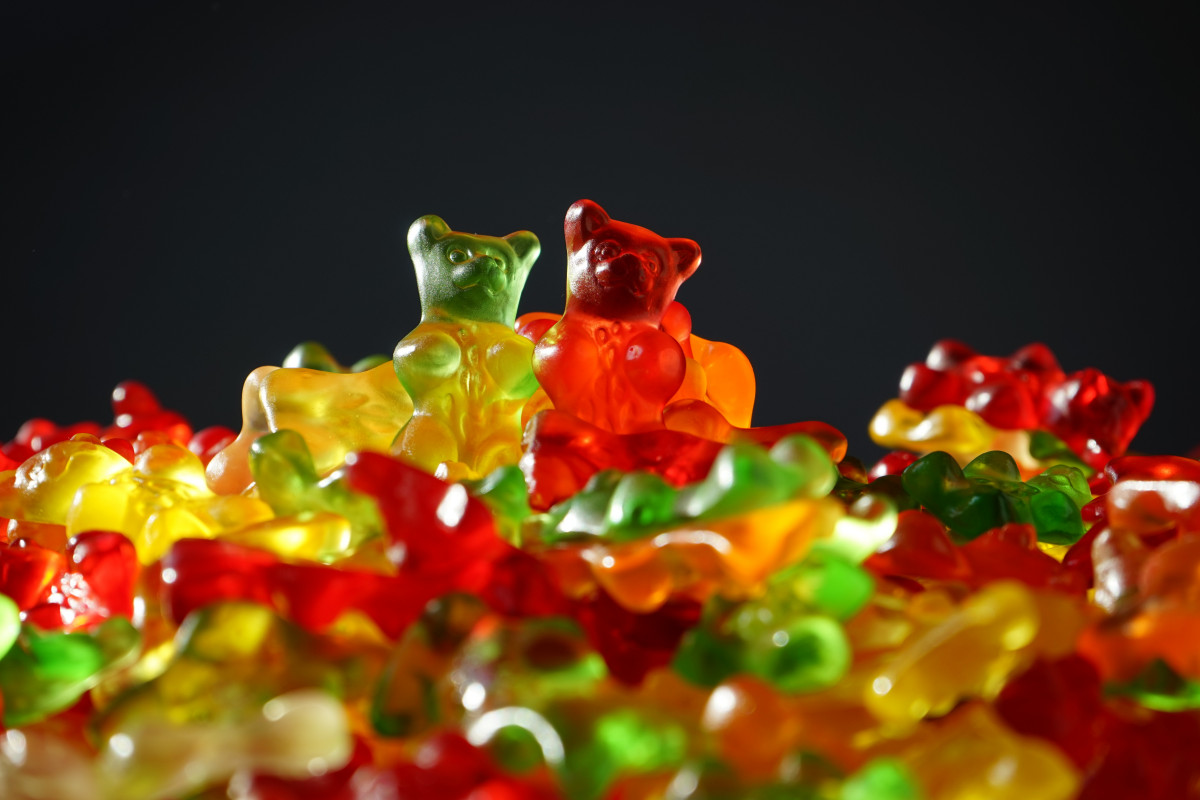Your cart is currently empty!

Gummy bears, with their vibrant colors, fruity flavors, and satisfying chew, are one of the most beloved candies worldwide. These chewy treats are a favorite among both children and adults, and their unique texture is what sets them apart from other candies. But what is it that makes gummy bears so chewy? The answer lies in the science behind the key ingredient: gelatin. In this article, we’ll explore how gelatin creates the perfect chew for gummy bears and dive into the fascinating process of their creation.
1. What is Gelatin?
Gelatin is a protein derived from animal collagen, which is found in the connective tissues, skin, and bones of animals. It’s made by boiling animal parts, such as pig or cow skin, in water to extract the collagen. This collagen is then purified and dried into a powder or sheets, which can later be dissolved in liquid to form a gel-like consistency.
Gelatin is unique because it has the ability to absorb large amounts of water and form a gel when it cools. This gel formation is what gives gummy bears their chewy texture and allows them to hold their shape. The process of making gummy bears is largely centered around manipulating the gelatin to create the desired consistency and texture.
2. The Role of Gelatin in Gummy Bears
The texture of a gummy bear is primarily determined by the gelatin concentration in the candy. Gelatin works by forming a network of long protein strands when dissolved in hot liquid. As the mixture cools, these protein strands intertwine, trapping water and other ingredients inside, which results in the firm but elastic texture we recognize in gummy candies.
- Gelatin as a Gelling Agent: When gelatin is mixed with water, it forms a hydrocolloid gel, which gives gummy bears their signature chewy consistency. The amount of gelatin used affects how firm or soft the gummies will be. More gelatin creates a firmer gummy, while less gelatin results in a softer, more elastic chew.
- Chewy Texture: The gelatin’s ability to absorb and retain water helps maintain the moisture balance in gummy bears, contributing to their soft and chewy texture. When you bite into a gummy bear, the gelatin forms a flexible, bouncy network that provides resistance as you chew, which is the defining characteristic of gummies.
3. The Process of Making Gummy Bears
Making gummy bears involves several key steps, with gelatin playing a central role at each stage.
- Heating the Ingredients: The process starts by heating a mixture of sugar, corn syrup, water, and gelatin. The gelatin is dissolved in the water and heated until it fully melts into the liquid, creating a smooth mixture. The sugar and corn syrup provide sweetness and additional texture, while the water helps create the gummy bear’s moisture content.
- Flavor and Color: Once the gelatin mixture is ready, flavorings, fruit juices, and food coloring are added to give the gummies their characteristic taste and appearance. These ingredients contribute to the fruity, sweet flavors that we associate with gummy bears.
- Molding: The liquid mixture is then poured into silicone molds shaped like gummy bears. The molds are filled with the warm, liquid candy mixture, which then begins to cool and set as the gelatin forms a gel.
- Cooling and Setting: The molds are left to cool for several hours, during which time the gelatin solidifies and takes on its chewy texture. The cooling process allows the gelatin to form a strong network, which helps the gummy bears retain their shape and texture.
4. Gelatin’s Role in the Gummy Bear’s Elasticity
Gelatin’s ability to create elasticity is crucial in making gummy bears appealing. Elasticity refers to the gummy bear’s ability to stretch and return to its original shape, which gives the candy its “bounce” when chewed.
The gelling process is what gives gummy bears the flexibility to bend and stretch. When you chew a gummy bear, the gelatin network flexes, allowing the candy to deform, but it quickly returns to its original shape once the pressure is released. This elastic characteristic is a result of the long protein chains in gelatin that create a mesh-like structure, offering both resilience and chewiness.
5. The Role of Other Ingredients
While gelatin is the star ingredient responsible for the chewy texture, other components also contribute to the final product.
- Sugar and Corn Syrup: These ingredients not only provide sweetness but also affect the texture of the gummy bears. Corn syrup helps prevent crystallization of sugar, making the final gummy smooth and not gritty. Sugar also plays a role in maintaining the softness of the gummy bear.
- Acids: Citric acid or tartaric acid is often added to the gummy mixture to provide tartness, balancing the sweetness and enhancing the fruity flavor. The acidity also interacts with the gelatin, influencing the texture and firmness of the gummies.
- Flavorings and Colorants: Natural or artificial flavorings are used to give gummy bears their signature fruity tastes, while food colorings are added to create the vibrant, colorful appearance of the candies.
6. The Texture Profile: How to Achieve the Perfect Chew
The perfect chewiness of a gummy bear is achieved through a precise balance of gelatin and other ingredients. The texture can be adjusted based on the amount of gelatin used in the mixture, the cooling process, and even the addition of certain acids.
- Firmness vs. Softness: By altering the gelatin concentration, manufacturers can create different textures. If the gelatin content is higher, the resulting gummy will be firmer and more resistant to breaking, creating a more substantial chew. Lowering the gelatin concentration results in a softer, more elastic texture.
- Elasticity and Bounciness: A key part of the chewy experience is how the gummy bounces back after being stretched. The longer the gelatin chains, the more elastic the candy will be. This balance between firmness and elasticity is what makes gummy bears enjoyable to eat—they have a perfect balance of resistance and bounce.
7. Vegan Alternatives to Gelatin
In recent years, with the growing demand for plant-based products, vegan gummy bears have gained popularity. Vegan gummy bears are made using agar-agar or pectin as a substitute for gelatin. Agar-agar, a substance derived from seaweed, forms a gel when combined with water, while pectin is a natural gelling agent found in fruits like apples and citrus. These alternatives mimic the texture of traditional gelatin-based gummies but are suitable for those following a vegan diet.
While the texture of vegan gummy bears may differ slightly—being less elastic and more jelly-like—these alternatives still provide a chewy, enjoyable experience.
8. Conclusion
The chewy, bouncy texture of gummy bears is thanks to the unique properties of gelatin, which creates a gel-like structure that forms the basis of the candy’s elasticity and chewiness. From the moment gelatin is dissolved in hot liquid to the final cooling process, it plays an essential role in shaping the texture and overall quality of gummy bears. Along with other ingredients like sugar, corn syrup, and flavorings, gelatin ensures that gummy bears maintain their signature chewy appeal, making them a timeless treat that continues to delight candy lovers around the world.

Leave a Reply